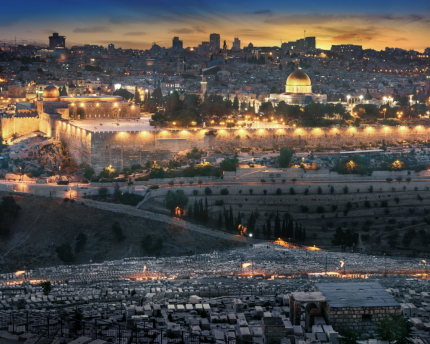
In signing a proclamation and announcing plans to move the U.S. Embassy from Tel Aviv to Jerusalem, Trump noted, "In 1995, Congress adopted the Jerusalem Embassy Act, urging the federal government to relocate the American embassy to Jerusalem and to recognize that that city ... is Israel’s capital."
In the years since, presidents have exercised the law's waiver, refusing to recognize Jerusalem as the capital city, he added. "Some say they [previous presidents] lacked courage, but they made their best judgments based on facts as they understood them at the time," Trump said.
After Trump's announcement, some warned that the decision could jeopardize the diplomatic process. The hope for peace has rested on a two-state solution. And a statement by United Nations Secretary‑General António Guterres makes clear that this is still the desire.
"In this moment of great anxiety, I want to make it clear: there is no alternative to the two-state solution," the statement said. "There is no Plan B. It is only by realizing the vision of two states living side‑by‑side in peace, security and mutual recognition, with Jerusalem as the capital of Israel and Palestine, and all final status issues resolved permanently through negotiations, that the legitimate aspirations of both peoples will be achieved."
This is an issue with a history that reaches back thousands of years. The first settlement of Jerusalem was in 3500 B.C., according to the Jewish Virtual Library. But to understand modern history's web of intractable issues, here are resources, along with links for further study.
100 years ago: This week marks a significant anniversary -- on Dec. 9, 1917, the British captured Jerusalem during World War I. Palestine, made up of what is now Israel, the West Bank, Gaza Strip and Jordan, was "among several former Ottoman Arab territories placed under the administration of Great Britain by the League of Nations," recounts the BBC's website. "The mandate lasted from 1920 to 1948." In 1923, the British granted limited autonomy to Jordan.
After World War II, the state of Israel was established. The plan, endorsed in 1947 by the United Nations General Assembly, called for the partition of Palestine, “providing for the creation of an Arab state and a Jewish state, with Jerusalem to be placed under international status,” the U.N. website explains.
In 1948, when the state of Israel was established, Jerusalem was divided by armistice between Israel and Jordan. Military observers arrived in the region in June 1948, according to the U.N. In 1949, they remained, “to supervise the Armistice agreements between Israel and its Arab neighbors, which were for many years the main basis of an uneasy truce in the area.”
On Dec. 13, 1949, the U.N. placed Jerusalem under international control.
A decade later, the Arab-Israeli war began June 5, 1967, when “Israel launched a preemptive strike against Egyptian forces in response to Egypt's closing of the Straits of Tiran,” according to the U.S. State Department's account. Israel gained control over the Sinai peninsula, the Golan Heights, the West Bank, the Gaza Strip and East Jerusalem. But Palestinians remained in these territories.
The administration of President Lyndon B. Johnson “sought Israel’s withdrawal from the territories it had occupied in exchange for peace settlements with its Arab neighbors. This formula has remained the basis of all U.S. Middle East peacemaking efforts into the present,” according to the State Department.
In the 1990s and throughout the 2000s, news accounts documented terrorist attacks against Israeli citizens, along with actions by the Israeli military. Thousands of Israeli and Palestinian lives have been lost in the process.
The possibility of peace: For years, American presidents and diplomats have attempted to broker peace. Notably, in 1979, President Jimmy Carter oversaw a historic peace accord between Israeli Prime Minister Menachem Begin and Egyptian President Anwar Sadat. Carter has been a proponent of a two-state solution. In his book, Palestine, Peace Not Apartheid, (Simon & Schuster; 2006), Carter outlines two interrelated obstacles to peace:
- "Some Israelis believe they have the right to confiscate and colonize Palestinian land and try to justify the sustained subjugation and persecution of increasingly hopeless and aggravated Palestinians; and
- "Some Palestinians react by honoring suicide bombers as martyrs to be rewarded in heaven and consider the killing of Israelis as victories."
Resources:
- BBC News: British control -- Mandate Palestine.
- Encyclopedia Britannica: Palestine.
- Encyclopedia Britannica: Suez Crisis, 1956.
- The Jewish Virtual Library: Timeline for the history of Jerusalem.
- The Jewish Virtual Library: Comprehensive listing of fatalities.
- Library of Congress: The surrender of Jerusalem to the British.
- The New York Times: March 26, 1979, Israel and Egypt sign peace treaty.
- PBS: The Evolution of Islamic Terrorism, an overview.
- United Nations: Statement of Secretary‑General António Guterres.
- United Nations Truce Supervision Organization: Background.
- U.S. State Department: Arab-Israeli War of 1967 (archive).
- U.S. State Department, Office of the Historian: The 1967 Arab-Israeli War.
- White House.gov: Presidential proclamation recognizing Jerusalem as the capital of the state of Israel and relocating the United States embassy to Israel to Jerusalem.
- White House.gov: Statement by President Trump on Jerusalem.
Related:
5 countries where women have led government
If you wish to comment, like us on Facebook and tell us what you think.